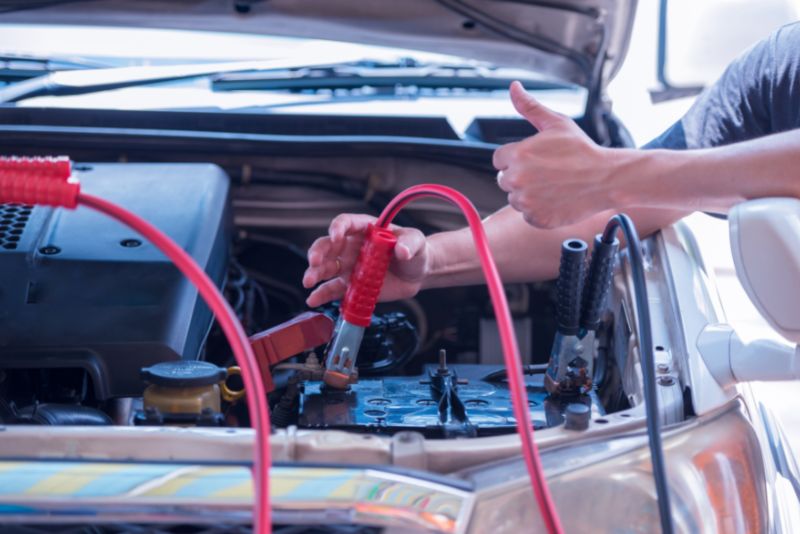How to jump start your car – and prepare your winter emergency kit!

We may have been blessed with one of the mildest Octobers on record, however November has certainly seen a turn in the weather.
Most of us are averse to rainy days, and our vehicles are even less keen. Add to that the decreasing temperatures as we approach Christmas and we could find ourselves in a spot of bother when we last expect it. Even if you already have breakdown cover, this time of year you can be kept waiting for a good couple of hours for help to arrive, not so great given the rain and dark nights.
According to the AA, their most common breakdowns called out to between December and February related to a flat battery (24%), tyre-related (16%), issues with intake and emissions (8%), starter and alternator faults (6%) and problems with locks and alarms (5%), with the team seeing a spike over the festive period in particular. Interestingly, the first day back at work in January usually sees the most callouts!
How to avoid a winter breakdown
Prevention is better than cure, and some simple maintenance and common sense steps could keep you on the road without event this winter.
Check your car battery voltage with a voltmeter – with an average lifespan of 4 to 5 years, it’s worth checking the voltage sooner rather than later. According to Mechanicbase.com, a ‘good’ reading should indicate a voltage between 12.4 V and 12.7 V. If you aren’t sure, your local garage can help.Check your headlights and replace any bulbs now – including your fog lights.Can you see out of your windscreen? Give yourself time to defrost your car in the morning and make sure your windscreen washed is topped up and antifreeze.Did you know that tyre pressure drops in cold weather? It’s even more important to keep an eye on your pressure and tread in the winter months. If you live somewhere where it’s prone to snow and ice, it may even be worth considering purchasing a set of winter tyres.Always MOT your car by the due date and service your vehicle as required for optimum safety and performance.
Emergency winter car kit
Whether you choose to buy one, or make one yourself, it’s important to spend time getting the contents right. Many of these items can be bought at a supermarket or online, and some you may already have at home.
There are plenty of resources out there that also suggest non-perishable snacks for emergencies, safety goggles, jump starter power packs just in case another vehicle isn’t around, a snow shovel, umbrella, shoe grips to wear in icy conditions and even cat litter to help you escape an icy trap. All great ideas, depending on your boot space.
What’s in your essential winter kit?
How to charge your car battery
The most common cause of winter breakdowns is a fault with a battery.
And the most common cause of a flat battery is leaving the headlights on when the engine is switched off. Another common cause is using your car for lots of smaller trips, leaving the battery little time to charge up in between journeys. This is particularly common if your battery is old.
Either way, you’re stuck: the battery powers the starter motor, and then the engine turns the alternator which recharges the battery. If you can’t get past the first hurdle there are some things you can do to jump-start your car.
Park the vehicles with the fully-charged battery facing the car with the flat one.Turn both cars off and engage parking brakes.Dead car: place red clamp on the (+) on the dead battery.Helper car: place red clamp on the (+) on the battery on their car.Helper car: place black clamp on the (-) on the battery of their car.Dead car: place black clamp on an unpainted metal surface.Wait 5 minutes.Start the helper car first, then start the dead car.If it doesn’t start immediately, wait another 10 minutes.Once running, leave the leads attached for 10 minutes to charge the dead battery.Remove clamps in reverse order.Take the car for a 30-minute drive.
This handy YouTube video from our friends at Halfords guides you through the process in just 2 minutes.
Remember – safety first!
Ensure your car is switched off and the key is out of the ignition.Call an expert if you are unsure, see signs of leaking, erosion, smoke or anything suspicious.Never touch the battery with anything metal.Never touch the clamps end to end and avoid moisture near the cables.
If the above guide doesn’t get you up and running, you will likely need breakdown assistance, such as A-Plan Rescue. For peace of mind, you can add this to your car insurance policy – if you haven’t arranged this already and would like to find out about adding this to your existing policy, your local branch would be happy to answer any questions you may have.


